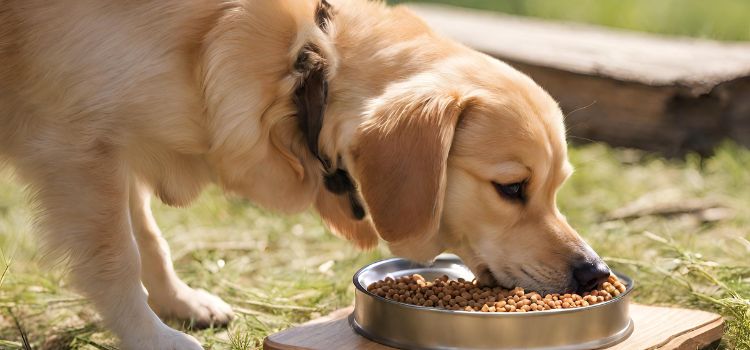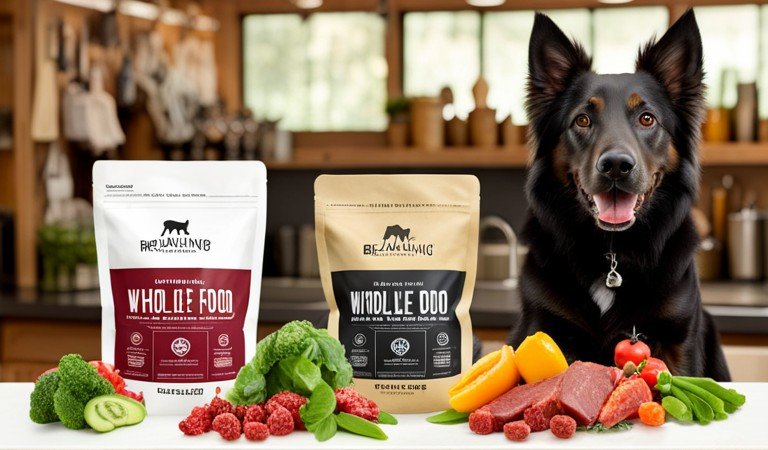As an Amazon Associate committed to the mission of improving the lives of our readers, Live-Clear.com receives a small commission from eligible purchases made through our affiliate links. This revenue enables us to keep producing insightful articles and other material.
Pine pellets are generally safe for dogs, as they are made from natural wood with no additives or harmful chemicals. However, it’s important to supervise your dog to ensure they don’t eat the pellets, which can cause intestinal obstructions or digestive issues.
Pine pellets are a popular choice for litter boxes, but they can also be used as a safer alternative to traditional bedding for dogs. Made from compressed sawdust, pine pellets are often free of the dust and allergens found in other bedding materials.

They also have natural odor control properties that can keep your home smelling fresh. However, it’s important to note that not all pine pellets marketed for pets are created equal. Some may contain additives or chemicals that can be harmful to dogs. It’s always best to check the label and do your research before introducing any new product to your furry friend.
What Are Pine Pellets?
Pine pellets are made from sawdust and are marketed as an eco-friendly and inexpensive option for cat litter and bedding for small animals. While they are generally considered safe for dogs, it is important to monitor your dog’s behavior around the pellets to ensure they are not ingesting them or experiencing any respiratory issues.
Pine pellets, also known as wood pellets, are a popular alternative to traditional cat litter and bedding for pets, including dogs. Pine pellets are made from compressed sawdust, which is a byproduct of the lumber industry. These pellets are highly absorbent, lightweight, and environmentally friendly. They are also becoming increasingly popular with pet owners due to their affordability, long-lasting nature, and natural pine scent. But are pine pellets safe for dogs? Let’s find out.
Composition Of Pine Pellets
Pine pellets are made from natural pine trees, which are ground up into sawdust and then compressed into small pellets. These pellets contain natural pine oil, which gives them their signature scent. Pine oil is a natural antimicrobial substance that can fight off bacteria and odors, making it an excellent choice for pet litter and bedding.
Uses Of Pine Pellets
Pine pellets have a wide variety of uses for dogs. They can be used as litter for puppies, providing them with a clean, absorbent surface to go potty on. Pine pellets can also be used as bedding for dogs, providing them with a soft, comfortable place to rest. Additionally, pine pellets can be used as a training aid, as they can be easily shaped into cones or other shapes for dogs to jump over or weave through.
Pine pellets are a safe and affordable option for pet owners, providing a natural and effective alternative to traditional litter and bedding. However, it’s important to note that some dogs may be sensitive to the pine scent or the dust created by the pellets, so it’s essential to monitor your dog’s reaction carefully. Overall, pine pellets are a fantastic option for pet owners, providing an environmentally friendly, absorbent, and cost-effective solution for pet litter and bedding needs.

Pros Of Using Pine Pellets
Pine pellets are made from natural wood, making them a safe and eco-friendly option for dog owners. They are highly absorbent and mask odors well, making them an excellent alternative to traditional clay litter. Additionally, they can be easily disposed of and are a cost-effective option in the long run.
If you’re a dog owner, you know how important it is to choose the right litter for your furry friend. One option that has gained popularity in recent years is pine pellet litter. Here are a few reasons why pine pellet litter is a great choice for your dog.
Eco-friendly
Pine pellet litter is considered eco-friendly because it is made from a renewable resource – pine trees. Unlike traditional clay litter, which is non-biodegradable and can sit in landfills for decades, pine pellet litter is biodegradable and can easily be composted. This means you can reduce your carbon footprint while keeping your dog comfortable.
Cost-effective
Another great thing about pine pellet litter is that it is cost-effective. A bag of pine pellet litter typically lasts longer than traditional clay litter because it has a higher absorbency rate. This means that you’ll need to change the litter less frequently, saving you money in the long run.
High Absorbency
Pine pellet litter has a much higher absorbency rate than traditional clay litter. This is because the pellets are made from compressed sawdust, which is highly absorbent. The pellets expand when they come into contact with liquid, trapping the urine and locking in odors. This means that your dog’s litter box will stay fresher for longer, making your life easier.
Pine pellet litter is a great choice for dog owners looking for an eco-friendly, cost-effective, and high-absorbency option. By choosing pine pellet litter, you can ensure that your dog stays comfortable while reducing your carbon footprint and saving money.
Cons Of Using Pine Pellets
Pine pellets come with several cons, including a strong odor that some dogs may not tolerate. The pellets are also known to cause respiratory problems in canines. Therefore, it’s essential to consider your pet’s health before using pine pellets as bedding.
Fragrance
Pine pellets are known for their strong, pleasant smell; however, this may not be ideal for some dogs. Dogs have highly sensitive noses, and the fragrance from the pine pellets may cause irritation or allergy. Inhaling the scent could also weaken the dog’s sense of smell, which is essential to their survival. Therefore, it’s important to observe your dog’s reaction to the pine pellet fragrance before using it as a regular alternative.
Tracking
Another disadvantage of using pine pellets is that they may get tracked around your home. When your dog steps on the pine pellets, they can stick to their paws and fall off in different areas of your home. This can be a significant inconvenience, as pine pellets can also damage some surfaces like carpets. If your dog is like most dogs and likes to explore around your home, pine pellets may not be the best choice for you.
Dust
Pine pellets are notorious for creating dust when they break down. Dust is a significant disadvantage of using pine pellets as it could potentially lead to respiratory issues and eye irritation, not just for dogs but also for humans. The dust can also spread around your home, causing discomfort and making cleanup a difficult task. Although some pine pellets claim to have reduced dust, it’s essential to pay attention to the level of dust that comes with any pine pellet brand you choose.
While pine pellets have their benefits, such as being environmentally friendly and affordable, they also have their disadvantages. For instance, the fragrance of the pellets can be too strong for some dogs, they can leave a trail of pellet crumbs around your home, and can create excessive dust. To ensure that the pine pellets you use are the right choice for your furry friend, it’s vital to observe their reaction to it and follow cleaning guidelines.

Are Pine Pellets Safe For Dogs?
Pine pellets can be safe for dogs, but it depends on the type and brand. Avoid pine pellets with added chemicals, fragrances or oils. It is best to consult with your veterinarian before using them for your furry friend.
Pine pellets are a popular bedding choice for small animals, such as hamsters and rabbits. However, many dog owners wonder if pine pellets are safe for their furry friends. Pine bedding contains phenols, which are compounds that can cause irritation and health issues for dogs. Before using pine pellets for your dog’s bedding, it’s important to consider the potential risks.
Possible Allergies
Like humans, dogs can develop allergies to various substances, including pine. Inhaling pine dust or coming into direct contact with pine bedding can trigger allergies in some dogs. Symptoms of allergic reactions to pine pellets can include sneezing, coughing, itching, and inflammation. Dogs with pre-existing respiratory conditions, like asthma, are at a higher risk of developing allergic reactions to pine. It is best to monitor your dog’s behavior and consult a veterinarian if you suspect an allergic reaction to pine pellets.
Ingestion Risks
Dogs have a habit of chewing and consuming almost everything around them. The ingestion of pine bedding can cause significant harm to your furry friend. The phenolic compounds present in pine pellets can cause digestive issues, including vomiting and diarrhea. Consuming large amounts of pine bedding can even lead to liver issues. It is advisable to supervise your dog when using pine bedding to ensure they don’t eat it. If you notice your dog consuming pine bedding, contact your veterinarian immediately.
Respiratory Problems
The phenols in pine pellets are known to cause respiratory issues in dogs. Inhaling too much pine dust can lead to respiratory distress, especially in dogs with pre-existing respiratory problems. The strong aroma of pine can also irritate the sensitive nasal passages of your dog, leading to sneezing, coughing, and wheezing. If you notice your dog having trouble breathing or exhibiting signs of respiratory distress, consult your veterinarian right away.
While pine pellets for bedding may be safe for some animals, they can cause various problems for dogs. It is recommended to avoid using pine pellets if your dog has allergies, respiratory conditions, or a habit of ingesting bedding material. If you must use pine pellets, monitor your dog closely and seek veterinary attention if you notice any unusual behavior or symptoms.
Alternatives To Pine Pellets
If you are concerned about using pine pellets for your furry friend, there are plenty of alternatives available. Here are a few:
Clay Litter
Clay litter is a popular choice among pet owners. It is absorbent, easy to use, and comes in a variety of scents. However, clay litter is not biodegradable and may contain harmful chemicals.
Silica Gel Litter
Silica gel litter is made from small, absorbent beads that trap odors and moisture. It is non-toxic, but can be dangerous if ingested by pets. Additionally, it is not biodegradable and should be disposed of carefully.
Recycled Paper Litter
Recycled paper litter is an eco-friendly option that is biodegradable and safe for pets. It is absorbent, odor-controlling, and dust-free. However, it may need to be replaced more frequently than other types of litter and can be more expensive.
There are many alternatives to pine pellets that are safe and effective for your dog. Consider the pros and cons of each option and choose the one that works best for you and your furry friend.
| Litter Type | Pros | Cons |
|---|---|---|
| Clay Litter | Absorbent, many scents available | Non-biodegradable, may contain harmful chemicals |
| Silica Gel Litter | Non-toxic, odor-controlling | Non-biodegradable, can be dangerous if ingested by pets |
| Recycled Paper Litter | Biodegradable, eco-friendly, dust-free | May need to be replaced more frequently, can be more expensive |

Conclusion
Overall, pine pellets can be safe for dogs if used properly. They offer benefits like odor elimination and low tracking, but certain precautions should be taken, such as soaking the pellets and ensuring that the dog does not ingest them.
Frequently Asked Questions For Are Pine Pellets Safe For Dogs
Yes, pine pellets can be used for dogs as a natural and eco-friendly alternative to traditional pet bedding. It’s important to choose pellets that are free from additives and chemicals, and to monitor your dog for any adverse reactions. Always make sure your dog has access to clean water and sufficient ventilation when using pine pellets as bedding.
Yes, pellets can be safe for dogs, but it depends on the type of pellet and how they are used. Pellets made specifically for dogs can provide a healthy and balanced diet, but other types, like wood pellets, can be dangerous if ingested.
If your dog eats wood pellets, it can cause blockages in their digestive system, leading to serious health issues. Symptoms may include vomiting, diarrhea, and loss of appetite. Immediate veterinary treatment is necessary to prevent further complications and better manage your dog’s condition.
To use pelletized bedding for dogs, simply spread it out on the surface of their bedding area. The pellets absorb moisture and odors over time and clump together, making it easy to scoop out soiled areas. It requires less maintenance than traditional bedding and is also dust-free, making it safer for your dog’s respiratory system.
Yes, pine pellets are safe for dogs to use as litter as they are made from natural, chemical-free pine sawdust.
Owners should also consider their dog’s individual needs and preferences when choosing a litter. As with any pet-care decision, it’s important to do your research and consult with your veterinarian.
Amazon and the Amazon logo are trademarks of Amazon.com, Inc, or its affiliates.



